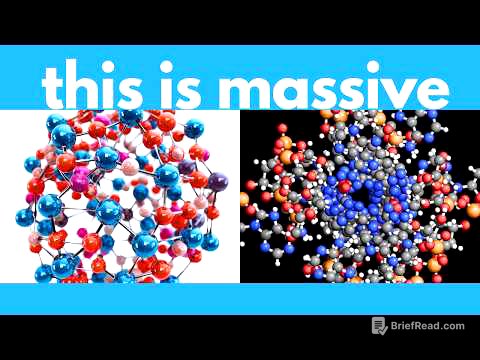TLDR;
This video provides a comprehensive overview of acids, bases, and salts, explaining their properties, types, reactions, and uses. It covers acid and base definitions, classifications based on aroma, strength, and concentration, and the concept of pH. The video also details various chemical reactions involving acids and bases, commonalities between them, and their importance in daily life. Additionally, it explores different types of salts and their chemical compounds, including sodium hydroxide, bleaching powder, baking soda, washing soda, and plaster of Paris, along with their respective uses.
- Acids are sour, release H+ ions in water, and turn blue litmus red.
- Bases are bitter, release OH- ions in water, and are classified by origin and strength.
- Indicators like litmus and turmeric identify acids and bases through color changes.
- pH scale measures acidity/basicity; values below 7 are acidic, above 7 are basic, and 7 is neutral.
- Salts are formed from acid-base reactions and have various chemical applications.
Introduction [0:00]
The video introduces the second chapter of class 10th science: acids, bases, and salts. It promises a concise and animated explanation to aid in exam preparation. The content aims to surprise viewers with new insights, presenting the chapter as an interconnected story.
Acids: Definition, Properties, and Types [0:55]
Acids are substances that taste sour and release hydrogen ions (H+) in aqueous solutions, turning blue litmus paper red. Acids are classified based on aroma, strength, and concentration. Organic acids, like citric acid in lemons, are naturally occurring, while inorganic acids, such as hydrochloric acid, are synthetically produced. Strong acids completely dissociate in water, releasing many H+ ions, while weak acids only partially dissociate, releasing fewer H+ ions. Concentrated acids are pure with less water, whereas dilute acids have more water content. Dilution of acids involves slowly adding acid to water to prevent explosions.
Bases: Definition, Properties, and Types [4:54]
Bases are substances that taste bitter and release hydroxide ions (OH-) in aqueous solutions. Bases are classified by origin, strength and concentration. Organic bases are naturally occurring, while inoff bases are synthetic. Strong bases completely dissociate in water, releasing many OH- ions, while weak bases release fewer OH- ions. Concentrated bases have a high base content and less water, while diluted bases have more water. All water-soluble bases are called alkalis, meaning all alkalis are bases, but not all bases are alkalis.
Indicators: Identifying Acids and Bases [7:32]
Indicators are chemical substances that identify acids or bases by changing color or smell. Natural indicators, like litmus and turmeric, are directly found in nature. Litmus turns red in acid and blue in base, while turmeric remains yellow in acid and turns blue in base. Synthetic indicators, such as methyl orange and phenol orange, are lab-prepared. Methyl orange turns red in acid and yellow in base, while phenol remains colorless in acid and turns pink in base. Olfactory indicators, like onion and vanilla essence, change smell. Onion smell remains in acids but disappears in bases, while vanilla essence smell remains in acids but not in bases.
Chemical Properties of Acids and Bases [10:01]
Acids react with metals to form salt and hydrogen gas (H2). Bases also react with metals to produce salt and hydrogen gas. Hydrogen gas can be tested by bringing a burning candle near it, causing a pop sound. Acids react with metal carbonates and metal hydrogen carbonates to form salt, carbon dioxide (CO2), and water, while bases do not react with metal carbonates and metal hydrogen carbonates. Carbon dioxide gas can be tested using lime water, which turns milky in the presence of CO2, eventually becoming colorless with excess CO2. Acids and bases neutralize each other to form salt and water. Metallic oxides react with acids to form salt and water, while non-metallic oxides react with bases to form salt and water.
Common Properties and Behavior in Water [15:44]
All acids contain hydrogen ions (H+), with strong acids having more H+ ions than weak acids; H+ ions are responsible for acidic properties. Similarly, all bases contain hydroxide ions (OH-), with strong bases producing more OH- ions than weak bases; OH- ions are responsible for basic properties. Acids in water form hydronium ions (H3O+) because H+ ions cannot exist alone. Bases in water produce hydroxide ions (OH-).
The pH Scale: Measuring Acidity and Basicity [16:48]
The pH scale, ranging from 1 to 14, measures the acidity or basicity of a substance. pH means power of hydrogen or potential of hydrogen. Values below 7 indicate acidity, above 7 indicate basicity, and 7 indicates neutrality. Lower pH values indicate stronger acids (red color), while higher pH values indicate stronger bases (dark blue color). The pH scale is crucial in daily life, as the human body functions effectively between pH 7 to 7.8. Acid rain is defined as rain with a pH less than 5.6. Tooth decay starts when mouth pH drops below 5.5. Plants require specific pH levels for healthy growth.
Salts: Formation and Chemical Compounds [21:20]
Salts are compounds formed by the neutralization reaction between acids and bases. Common salt chemicals include sodium hydroxide (NaOH), also known as caustic soda, which is prepared through the electrolysis of sodium chloride (NaCl) solution and used in making soap and detergents. Bleaching powder (calcium hypochlorite, CaOCl2) is formed by adding chlorine to slaked lime and is used in bleaching industries and as a disinfectant. Baking soda (sodium hydrogen carbonate, NaHCO3) is formed by reacting salt water, carbon dioxide, and ammonia, and is used in cold drinks, fire extinguishers, and medicines. Washing soda (Na2CO3·10H2O) is formed by heating baking soda and reacting the product with water, and is used in glass, soap, and paper industries, as well as for removing water hardness. Plaster of Paris (CaSO4·1/2 H2O) is formed by heating gypsum at 100 degrees Celsius and is used to make surfaces smooth, toys, idols, and for plastering fractured bones.









